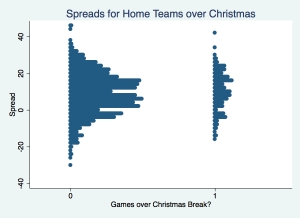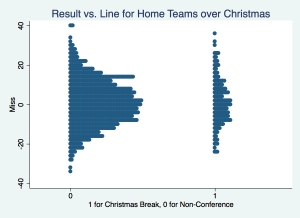This ten day period before New Years marks a pause in the frenetic college basketball schedule. Teams take time off for exams and the Christmas holiday, often not playing games for ten days at a time. Yet almost every team in college basketball will play at least one, if not two games during the post-exams/Christmas period.
Conventional wisdom and anecdotal evidence holds that these breaks, and the distractions around this time of year, can lead to letdowns, especially for favored teams. In fact, just last week Pittsburgh lost to Wagner, #4 Louisville trailed at home to both College of Charleston and Western Kentucky, Michigan struggled with Bradley, and Kansas lost to Davidson. All of these teams were heavily favored at home. Jeff Goodman summed up this view succinctly, tweeting that “Louisville’s players look as though they have already left for Christmas. Down early to WKU but Cards should come back.”
But do BCS home teams really perform worse than usual during this exam break? Do they schedule easier competition to account for poorer play? Looking at my database of 35,000 college basketball betting lines and results from 1996-2011, this does not appear to be the case. As I have explained before, the Vegas line, while imperfect, is still the best predictor of game results. It also is a great way for us to judge performance: if teams really do play worse over this break, we should either see them doing significantly worse relative to the lines. In my dataset, that worse performance simply is not there.
I defined my timeframe as games played between December 19th and December 28th. These specific dates could have been moved a day one way or the other, but the range covers the first game back for most teams after exams, and any games played around the Christmas break. Most teams let players go home for Christmas itself before having them back to campus for the next game. If there is a “Christmas/exams” letdown, it would appear in these games.
I compared performance in these games to performance in non-conference games prior to exams (November-December) because other non-conference games are a fair peer group at a similar level of competition–conference play can differ dramatically. The first issue to look at is whether teams schedule easier games during this period. The raw data is summarized in a table below:

Unsurprisingly, BCS teams are usually big favorites in non-conference home games. They are, on average, a point bigger favorites (-9.3 vs. -8.3) in Christmastime/ exam period games, but this difference is not statistically significant (using both t-tests and a Kolmogorov-Smirnov test of equivalence of distributions). While the level of competition during the exams/Christmas period is on average a bit easier, it does not appear that teams are scheduling down significantly during this period.
What about performance against that expectation? Again, there does not appear to be a significant divergence in results over exams/Christmastime. At home, BCS teams outperformed the line by an average of 0.5 points in the rest of non-conference play. Over the exam/Christmas period, they outperformed the line by an average of 0.8 points, a small and insignificant difference. The two samples also have almost identical standard deviations, meaning results are not spread out more from the line over the Christmas period.
One might argue that looking at simply the average and standard deviation is not enough. Maybe on average teams do well, but a portion of the BCS favorites simply collapse and lose big at home, missing the line substantially. Let’s look the two distributions of results compared to the Vegas line (positive numbers indicate that the home team outperformed the line, negative that they underperformed):
Visually, it does not appear that the two distributions differ much at all. This is confirmed by the Kolmogorov-Smirnov test. What this means is that, relative to the Vegas line, the distribution of a BCS home team’s performance is the same in the rest of the non-conference as it is over the exams/Christmas period. There does not appear to be any evidence for a Christmas letdown or worse performance.
While this analysis focused on the home teams, it also tells us about the converse: road performance over the period in question. The teams that travel to play BCS opponents over Christmas do not do significantly better than their counterparts over the rest of the non-conference. This lack of significance extends across the country: including non-BCS home games over the break does not change the finding.
The numbers are convincing, but do not tell the whole story. One caveat may be that Vegas prices in some poorer performance, and thus the spreads for exams/Christmas games are artificially suppressed. More qualitatively, it does seem that teams do perform more sloppily after long breaks. What is clear, however, is that this sloppiness is not somehow only limited to favored home teams.
Your favorite team may lose a shocker over this Christmas and exams period, but if they do, please buck the conventional wisdom and do not blame it on the season.



The problem with comparing to the Vegas lines is that the Vegas lines might already be shifting with the letdown in mind.